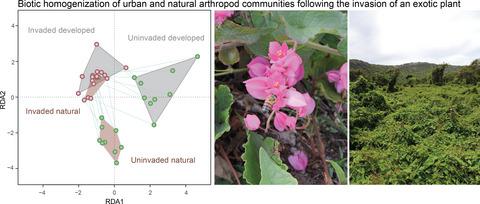当前位置:
X-MOL 学术
›
Glob. Change Biol.
›
论文详情
Our official English website, www.x-mol.net, welcomes your
feedback! (Note: you will need to create a separate account there.)
Disentangling the effects of plant species invasion and urban development on arthropod community composition.
Global Change Biology ( IF 10.8 ) Pub Date : 2020-04-16 , DOI: 10.1111/gcb.15091 Wendy A M Jesse 1 , Jasper Molleman 1 , Oscar Franken 1 , Mark Lammers 1, 2 , Matty P Berg 1, 3 , Jocelyn E Behm 4 , Matthew R Helmus 4 , Jacintha Ellers 1
Global Change Biology ( IF 10.8 ) Pub Date : 2020-04-16 , DOI: 10.1111/gcb.15091 Wendy A M Jesse 1 , Jasper Molleman 1 , Oscar Franken 1 , Mark Lammers 1, 2 , Matty P Berg 1, 3 , Jocelyn E Behm 4 , Matthew R Helmus 4 , Jacintha Ellers 1
Affiliation

|
Urban development and species invasion are two major global threats to biodiversity. These threats often co-occur, as developed areas are more prone to species invasion. However, few empirical studies have tested if both factors affect biodiversity in similar ways. Here we study the individual and combined effects of urban development and plant invasion on the composition of arthropod communities. We assessed 36 paired invaded and non-invaded sample plots, invaded by the plant Antigonon leptopus, with half of these pairs located in natural and the other half in developed land-use types on the Caribbean island of St. Eustatius. We used several taxonomic and functional variables to describe community composition and diversity. Our results show that both urban development and A. leptopus invasion affected community composition, albeit in different ways. Development significantly increased species richness and exponential Shannon diversity, while invasion had no effect on these variables. However, invasion significantly increased arthropod abundance and caused biotic homogenization. Specifically, uninvaded arthropod communities were distinctly different in species composition between developed and natural sites, while they became undistinguishable after A. leptopus invasion. Moreover, functional variables were significantly affected by species invasion, but not by urban development. Invaded communities had higher community-weighted mean body size and the feeding guild composition of invaded arthropod communities was characterized by the exceptional numbers of nectarivores, herbivores, and detritivores. With the exception of species richness and exponential Shannon diversity, invasion influenced four out of six response variables to a greater degree than urban development did. Hence, we can conclude that species invasion is not just a passenger of urban development but also a driver of change.
中文翻译:

弄清植物入侵和城市发展对节肢动物群落组成的影响。
城市发展和物种入侵是对生物多样性的两个主要全球性威胁。这些威胁常常同时发生,因为发达地区更容易入侵物种。但是,很少有经验研究检验这两个因素是否以相似的方式影响生物多样性。在这里,我们研究了城市发展和植物入侵对节肢动物群落组成的个体和综合影响。我们评估了36种被入侵的和未入侵的样地,它们受到了植物Antigonon leptopus的入侵,其中有一半成对分布在加勒比海的圣尤斯达蒂斯岛上,这些成对存在于自然环境中,另一半处于发达的土地利用类型。我们使用了几个分类和功能变量来描述社区组成和多样性。我们的研究结果表明,城市发展和A. leptopus入侵都会影响社区组成,尽管以不同的方式。发展显着增加了物种丰富度和指数香农多样性,而入侵对这些变量没有影响。但是,入侵显着增加了节肢动物的丰度并导致生物均质化。特别是,未入侵的节肢动物群落在发达和自然地点之间的物种组成明显不同,而在钩端螺旋体入侵后它们却变得无法区分。此外,功能变量受到物种入侵的显着影响,但不受城市发展的影响。入侵社区具有较高的社区加权平均体重,入侵节肢动物社区的进食行会组成以油桃,食草动物和有害菌的数量众多为特征。除了物种丰富和指数香农多样性以外,入侵对六个响应变量中的四个的影响程度都比城市发展更大。因此,我们可以得出结论,物种入侵不仅是城市发展的客流,而且是变革的驱动力。
更新日期:2020-03-26
中文翻译:

弄清植物入侵和城市发展对节肢动物群落组成的影响。
城市发展和物种入侵是对生物多样性的两个主要全球性威胁。这些威胁常常同时发生,因为发达地区更容易入侵物种。但是,很少有经验研究检验这两个因素是否以相似的方式影响生物多样性。在这里,我们研究了城市发展和植物入侵对节肢动物群落组成的个体和综合影响。我们评估了36种被入侵的和未入侵的样地,它们受到了植物Antigonon leptopus的入侵,其中有一半成对分布在加勒比海的圣尤斯达蒂斯岛上,这些成对存在于自然环境中,另一半处于发达的土地利用类型。我们使用了几个分类和功能变量来描述社区组成和多样性。我们的研究结果表明,城市发展和A. leptopus入侵都会影响社区组成,尽管以不同的方式。发展显着增加了物种丰富度和指数香农多样性,而入侵对这些变量没有影响。但是,入侵显着增加了节肢动物的丰度并导致生物均质化。特别是,未入侵的节肢动物群落在发达和自然地点之间的物种组成明显不同,而在钩端螺旋体入侵后它们却变得无法区分。此外,功能变量受到物种入侵的显着影响,但不受城市发展的影响。入侵社区具有较高的社区加权平均体重,入侵节肢动物社区的进食行会组成以油桃,食草动物和有害菌的数量众多为特征。除了物种丰富和指数香农多样性以外,入侵对六个响应变量中的四个的影响程度都比城市发展更大。因此,我们可以得出结论,物种入侵不仅是城市发展的客流,而且是变革的驱动力。











































 京公网安备 11010802027423号
京公网安备 11010802027423号